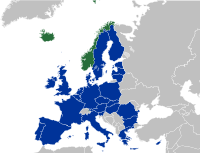European Economic Area
From Wikipedia, the free encyclopedia
 EFTA member countries (except Switzerland) European Union member-states |
|
| Union type | Economic market |
|---|---|
| Established | 1994 |
| Members | |
| Governance | |
| Basis | EEA Agreement |
| Institutions | EEA Council EU Commission EFTA SA ECJ EFTA Court |
| Affiliated with | European Union European Free Trade Area |
| Statistics | |
| Population | 506,465,094 |
| Area | 4,944,753 km2 |
The European Economic Area (EEA) was established on 1 January 1994 following an agreement[1] between Norway, Iceland and Liechtenstein and the European Union (EU). It allows these countries to participate in the EU's single market without joining the EU. In exchange, they are obliged to adopt certain EU internal market legislation.
Contents |
[edit] Membership
- Further information: EU enlargement to EFTA states
The EEA Agreement, signed in 1993, was between the European Free Trade Association (EFTA) states, the European Economic Community (EEC), the European Coal and Steel Community (ECSC) and the then-12 EEC/ECSC member states. The EEC/ECSC quickly became the EU and expanded to 27 member as of 2009, including three former EFTA members: Austria, Finland and Sweden. One EFTA member, Switzerland never ratified the agreement. A referendum (mandated by the Swiss constitution) was held in 1993 and rejected the proposal to join.[2] Switzerland is instead linked to the European Union by the Swiss–EU bilateral agreements, with a different content from that of the EEA agreement. Thus, the current contracting parties of the EEA Agreement, as of 2010, are: the EU and its 27 members, Iceland, Liechtenstein and Norway (except for Svalbard[dubious ]).
[edit] Freedoms and obligations
The EEA is based on the same "four freedoms" as the European Community: the free movement of goods, persons, services, and capital among the EEA countries. Thus, the EFTA countries that are part of the EEA enjoy free trade with the European Union.
As a counterpart, these countries have to adopt part of the Law of the European Union. These states have little influence on decision-making processes in Brussels.
The EFTA countries that are part of the EEA do not bear the financial burdens associated with EU membership, although they contribute financially to the European single market. After the EU/EEA enlargement of 2004 there was a tenfold increase in the financial contribution of the EEA States, in particular Norway, to social and economic cohesion in the Internal Market (€1167 million over five years).
EFTA countries do not receive any funding from EU policies and development funds
[edit] Legislation

The non EU members of the EEA (Iceland, Liechtenstein and Norway) have agreed to enact legislation similar to that passed in the EU in the areas of social policy, consumer protection, environment, company law and statistics. These are some of the areas covered by the European Community (the "first pillar" of the European Union).
The non EU members of the EEA have no representation in Institutions of the European Union such as the European Parliament or European Commission. In February 2001, Norwegian Prime Minister Jens Stoltenberg described the situation as a “fax democracy”, with Norway waiting for their latest legislation to be faxed from the Commission.[3]
[edit] Institutions
A Joint Committee consisting of the EEA-EFTA States plus the European Commission (representing the EU) has the function of extending relevant EU law to the non EU members. An EEA Council meets twice yearly to govern the overall relationship between the EEA members.
Rather than setting up pan-EEA institutions, the activities of the EEA are regulated by the EFTA Surveillance Authority and the EFTA Court, which parallel the work of the EU's European Commission and European Court of Justice. See EEA institutions for further information.
[edit] EEA and Norway Grants
The EEA and Norway Grants are the financial contributions of Iceland, Liechtenstein and Norway to reduce social and economic disparities in Europe. In the period 2004- 2009, €1.3 billion of project funding is made available for project funding in the 15 beneficiary states in Central and Southern Europe.
The EEA and Norway Grants were established in conjunction with the 2004 enlargement of the European Economic Area (EEA), which brings together the EU, Iceland, Liechtenstein and Norway in the Internal Market.
[edit] See also
- EudraVigilance
- Free trade areas in Europe
- EU enlargement to EFTA states
- Parallel importation
- Schengen Agreement
- Trade bloc
[edit] References
- ^ EEA AgreementPDF (199 KB)
- ^ Swiss reject EEA
- ^ In Norway, EU pros and cons (the cons still win) iht.com
[edit] External links
- More about the EEA on the website of the Mission of Norway to the EU
- EFTA Secretariat
- EEA Grants and Norway Grants
- EFTA Surveillance Authority
- The EU and the European Economic Area Europa (web portal): External Relations
|
||||||||||||||||||||||||||||||||
|
||||||||||||||||||||||||||||||||||||||||||
|
|||||||||||||||||